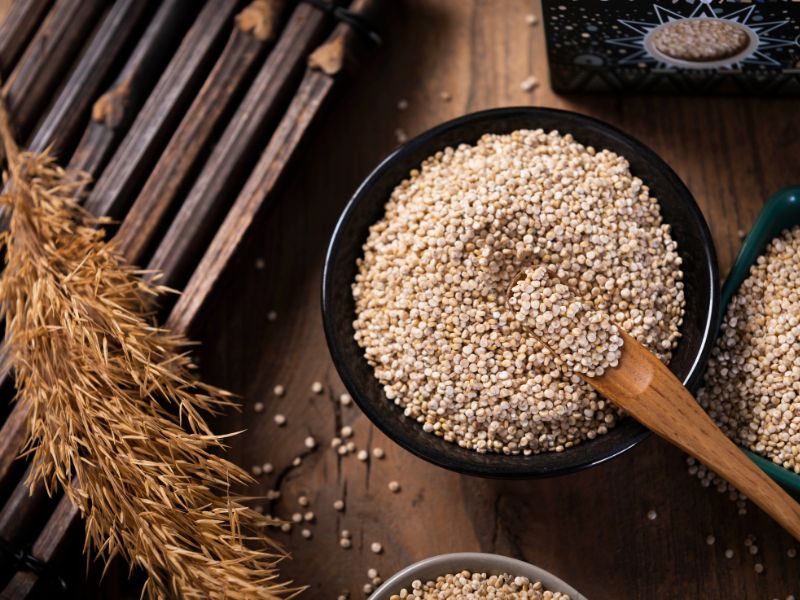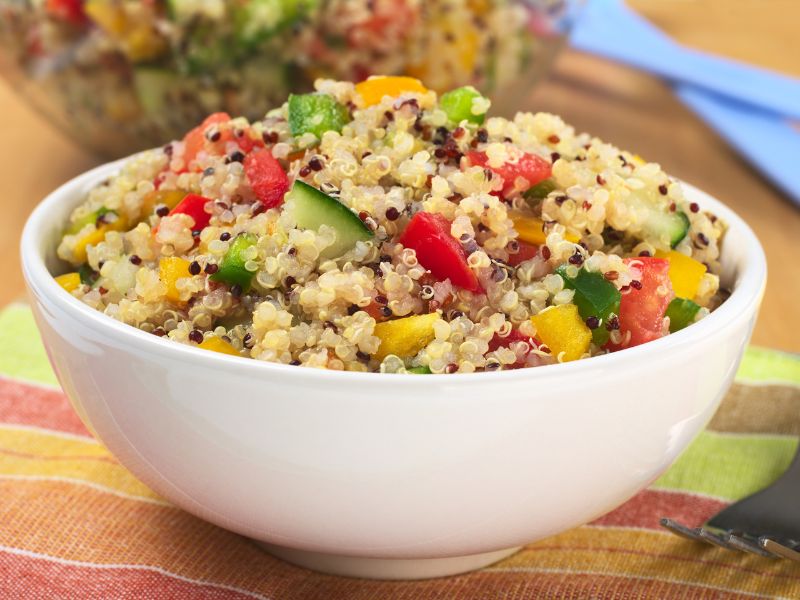A lot of people are still in the dark about this nutrient dense, superfood and have no idea how or when to use it.
But, quinoa, however, is way more versatile than you might think and can be added happily to both sweet and savoury dishes as either a side, or the star of the show. Yes, that’s the beauty of this wonderful superfood seed, its versatility.
In this post, we will explain quinoas truly astounding health benefits and nutritional profile.
What Is Quinoa made of?
Quinoa is presumed by most to be a grain, but is in fact, a seed from a flowering plant in the amaranth family. The very fact that it’s a seed makes it much healthier and more digestible to eat.
Given the fact that it can easily be used in place of your normal higher carb, lower nutrient grains makes it also a great metabolism boosting food also.
Quinoa: The ancient grain

This awesome seed has been used since ancient times and was eaten by the Incas who powered themselves on it whilst building the pyramids. This would have certainly been no mean feat requiring huge amounts of muscle power and energy, of which they derived mainly from quinoa.
So, take heed muscle builders! This little seed not only packs a powerful amino acid punch, but is actually a complete protein on its own right. No meat required!
Is quinoa better for you than rice?
That’s most definitely a YES!
Not only is it quinoa more nutritionally dense than rice (even wholegrain rice), it’s also is MUCH higher in protein and nutrition in general. In fact, quinoa is better for you nutritionally than any other grain.
You can eat it this wonderful seed everyday in place of any of your usual carbohydrates of rice, pasta, couscous, bulgar wheat or white potatoes. It is super versatile, has a neutral flavour, and easily soaks up the flavours of other foods. This makes it perfect to add to soups, casseroles, salads or pretty much anything you fancy.
Try quinoa in one of our delicious, breakfast bowls. It really helps give you a boost of brain powder and energy for the day, just like the Incas.
Which types of quinoa are there?
The most common types of quinoa come in the white, red or black variety. The white tends to go well as a replacement for rice because it more readily absorbs flavours.
The red and black hold their texture and shape well and are better in cold salads, or dishes where you need some texture and bite. It’s also a good idea to mix them together so you get the whole range of nutrients and textures.
You can also buy them all mixed together already packaged like this and are known as tri-coloured quinoa.
Quinoa Nutritional Profile
Quinoa’s carbohydrate content comes in at about mid range, but this is no reason to exclude it from a general low carb diet because it also offers many benefits that other carbohydrates don’t. These include having high protein content and LOTS of nutrients, including fibre, magnesium, phosphorus, zinc, lysine, iron and a range of B vitamins.
Nutritional value of 1 cup of cooked quinoa:
- Manganese – 58% RDA
- Magnesium – 30% RDA
- Phosphorus – 28% RDA
- Folate – 19% RDA
- Copper – 18% RDA
- Iron – 15% RDA
- Zinc – 13% RDA
- Potassium – 9% RDA
- PROTEIN – 8 GRAMS
- FIBER– 5 GRAMS
- OMEGA 3 FATTY ACID’S
Quinoa Health Benefits
1. Complete Amino Acid Profile

Quinoa is high in protein and the only known plant food to contain all the essential amino acids which are the building blocks of protein, and crucial to good health in general.
This makes quinoa not only perfect for vegetarians and vegans, but also a fantastic food for those in training. It’s a great way to use plant proteins to build lean muscle mass without the use of too many acid forming animal products.
2. Gluten Free
Using quinoa instead of the usual gluten free products such as potato, corn, rice and tapioca flour is a lot healthier, as it has a far superior antioxidant and nutrient content.
Obviously, the others have their place, if not just for variety. But you really should try to add quinoa as much as possible if you want superior health and strength.
It’s good to remember that a good deal of gluten free products are actually far from healthy, especially things like breads, biscuits, cakes and all those other ‘naughty but nice’ junk foods. These are all laden with sugar, unhealthy fats, and often nasty chemicals and additives to help aid with texture, taste and preservation.
3. Contains Plant Flavenols
There are literally thousands of trace nutrients in quinoa, consisting of many that we are not familiar with or have even heard of.
The two particular antioxidants that quinoa is abundant in are quercetin and kaempferol. These two antioxidants have been widely studied in animals and have been found to be anti-inflammatory, anti-viral, anti-cancer and anti-depressant.
This is interesting, because the main ways to alleviate depression and anxiety is to eat a low GI diet, high in antioxidants and omega 3’s. Quinoa happens to have ALL of these benefits rolled into one.
So, Eating quinoa has got to be a no-brainer if you want to feel happier, calmer, and generally more zen.
4. Source Of Fibre
Quinoa has more fibre than other grains, making this yet another reason (as if you needed any more) why it is so healthful.
Fibre is needed to lower a food’s GI and ensure a slow release of energy. However, it also lowers cholesterol, fills you up and stops you from snacking in-between meals. All this means extra fat burning, weight loss, and weight maintenance.
Fibre also plays a role in digestive tract health. It helps keep you regular, which in turn helps to keep your body detoxified and YOU firing on all cylinders with high energy and vitality.
Let’s also not forget the beautiful glowing complexion you will have when your are detoxifying adequately. Fibre literally drags impurities out of your system through the digestive tract.
5. Low Glycemic Index
All of these extra nutrients and protein help to slow down the rate in which quinoa’s carbohydrates hit the bloodstream, thus making it a low GI food. GI (glycemic index) is the measurement of how fast the sugar’s in a food hit the bloodstream ready to be used for energy. The slower, the better, when it comes to health.
All this is because high GI foods cause a much stronger insulin response from the pancreas. This in turn can lead to those sugars be stored away as dangerous belly fat.
Low GI foods offer a slow release of sugars that will be more readily burnt off as energy. This is definitely something to consider when choosing your carbohydrates for your meals, especially if you are prone to gaining weight easily.
Low GI carbs for weight loss

Instead of eating bread, rice, pasta, couscous, white potatoes and other high carb foods, you should try to use quinoa. Along with lentils, beans, chickpeas, millet, oats, pulses, amaranth and buckwheat. These are all lower GI, complex carbohydrates that will leave you feeling less bloated and with more energy. They are far more nutritionally superior to high GI, junk foods.
How To Cook Quinoa
Cooking quinoa is pretty easy and no more fuss than cooking any other grain or pasta.
Just boil in a little salted water if you want it straight up, as it comes. Or, you may prefer to cook it with a stock cube for flavour. Quinoa is quite bland on its own and usually needs some kind of seasonings.
Only use as much water as you need to cook the quinoa in and no more. You can then add more water in if needed as you go along. This way you won’t throw away any water at the end losing all the flavours you have added. OR, alternatively you could add spices of your choice afterwards.
Quinoa should be either soaked for a few hours first to get rid of impurities, or washed thoroughly before use.
This Youtube video will give you some other ways to prepare your quinoa, so you can always keep it fresh and exiting.


I have never made quinoa before, but I have had it and I actually love it. I am always low in magnesium, and supplements only have 3%, which is crazy. So now that I see I can get this from something I love, I am going to purchase it and start incorporating it in my diet. My son and I are both on a diet. He is not over weight, but doing it for muscle. Anyway we have been eating nothing but grilled chicken and rice with veggies. I like that I can substitute the rice some days for the quinoa. Thanks for sharing!
Hi there, yes I can see how you are probably getting very bored of rice and chicken. I used to live on that too before I went plant based. Definitely give quinoa a shot, especially if you are low on magnesium. The thing with magnesium is it is a bulky kind of mineral that has lots of substance to it so you are never going to get much in a general multivitamin supplement. You would need to buy a separate supplement which are usually quite large, or a powder. It takes pretty much a whole teaspoon of pure powder to give you 400mg of magnesium (which is a good amount you would need to get your levels up again).
You would feel a lot better if you replenished yourself of this mineral as being low can cause all sorts of problems over time. I would only suggest that you buy from a good brand as many commercial magnesium supplements are literally in an unabsorbable form and useless in the body. Trusted brands that I can think of off the top of my head are ‘Nature’s Plus’, ‘Viridian’, ‘BioMag’. I think all of these are available in the US.
Thank you so much Stefanie! I plan on it! Same goes for potassium too I am sure?
Yes, I think so, though I think potassium would be in smaller amounts, I would have to check with my herbalist at work. But often you can but potassium and magnesium together in one supplement so it’s worth having a look about.
Anyway, I’m glad to have been of help to you.
Hi Sam, thanks for reading and commenting and I’m glad you found the post interesting. Yep, it really is good stuff that quinoa hey, I’m going to start eating it all the time now haha
I love quinoa. I started using it to replace rice. My whole family loves it. We now even use it it soups and stews. Thanks for this article. I’ll certainly cook with it even more often now.
Hi Wendi, yes it’s great stuff isn’t it? Glad you’re already using it as lots of people haven’t even heard of the stuff ha ha. Thanks for commenting.
Yes I know, I didn’t realise just how good quinoa was until I researched it in depth for this article which has given me the impetus to eat it more also. Plus it tastes great, especially if you add some spices and favourings to it. My favourite is vegetable boullion powder.
Glad you found the article informative, oh can expect many more in the future.
Thanks for sharing. I’ve had this a few times, it’s not bad, it’s actually something really easy to add to your meal and switch out a carb. I’d switch it with the vegies I don’t like, but as we get older those things need to stay. Thanks for sharing! Very informative post. I learnt something, didn’t know about the protein content.
I’m really glad you have learnt something new with my post as that is my aim. I absolutely love quinoa these days and often have it as my carb with meals. It is actually really versatile and can have so many different herbs and spices added to it for different variations.
Another great way to eat quinoa is actually as a breakfast or a dessert. You can book it in nut milk, sweetener, cinnamon etc. Pretty much anything you fancy, then add nuts, fresh fruit, or just have it plain like a rice pudding. Delicious!
Hi and thanks for introducing quinoa to me.
I haven’t heard of this valuable seeds before and they look very tasty to me.
I wonder if I could grow them here in Thailand, a rather hot and dry environment.
I love to eat beans, grains, and seeds of all kinds and am always welcome to learn about new varieties 🙂
Hi Stefan, sounds like you have a good diet; especially as you live in Thailand. I love Thai food as it is just so healthy and full of fresh fruit and veg. Delicious!
I’m not sure about whether you can grow quinoa in Thailand, but I’m pretty sure you could get hold of it. It’s definitely worth a try as it is just so healthy.
Hey there, no problem. There is a lot to know about it isn’t there? Who knew; it sure is a fantastic food!